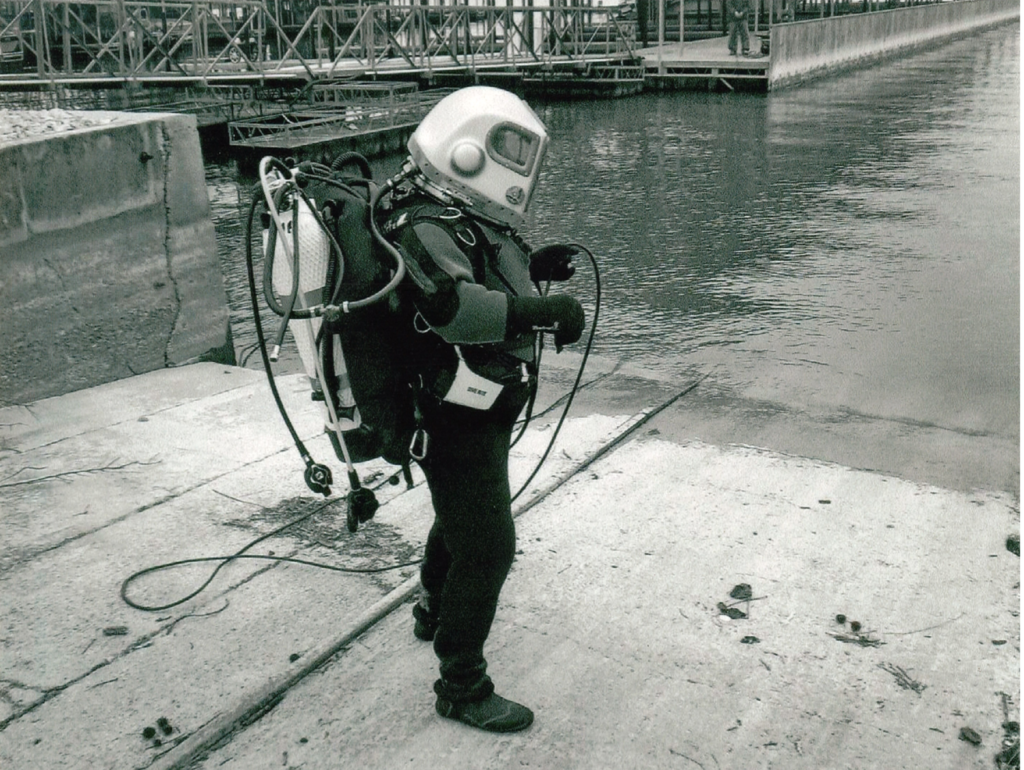
Photo courtesy of Atlantis Dive & Dock Salvage
When big things sink in the Lake, Tim McNitt — aka ’The Walrus’ — gets to float them
by Nathan Bechtold & Al Griffin
Ask Tim McNitt of Atlantis Dive & Dock Salvage for an interesting story, and you’d better get comfortable. When your job is diving for sunken things in Lake of the Ozarks, you end up with a few stories to tell. It turns out, floating giant objects can become a comedy of errors in dangerous places.
McNitt — known affectionately as “The Walrus” thanks to his appearance in a wetsuit — has spent more than 30 years swimming into danger and adventure from the Mississippi River to Lake of the Ozarks. He runs Atlantis on Lake of the Ozarks, but he explores deep waters as far away as Kansas, Tennessee, and Illinois. When something expensive sinks, McNitt dons his dive gear and jumps in the water: that means things like cellphones (yes they’ll still work!) and diamond rings.
But it’s the bigger items that tend to get unpredictable. Ask McNitt, and the stories range from nail-biting to downright hilarious…
The Plane
In 2015, a 1976 Beechcraft B19 crash-landed in Lake of the Ozarks. The plane ditched fairly close to land: less than 100 yards from the shoreline, just a stone’s throw from Public Beach #2. Miraculously, the three occupants — the pilot, his 73-year-old mother, and his 9-year-old daughter — made it out alive.
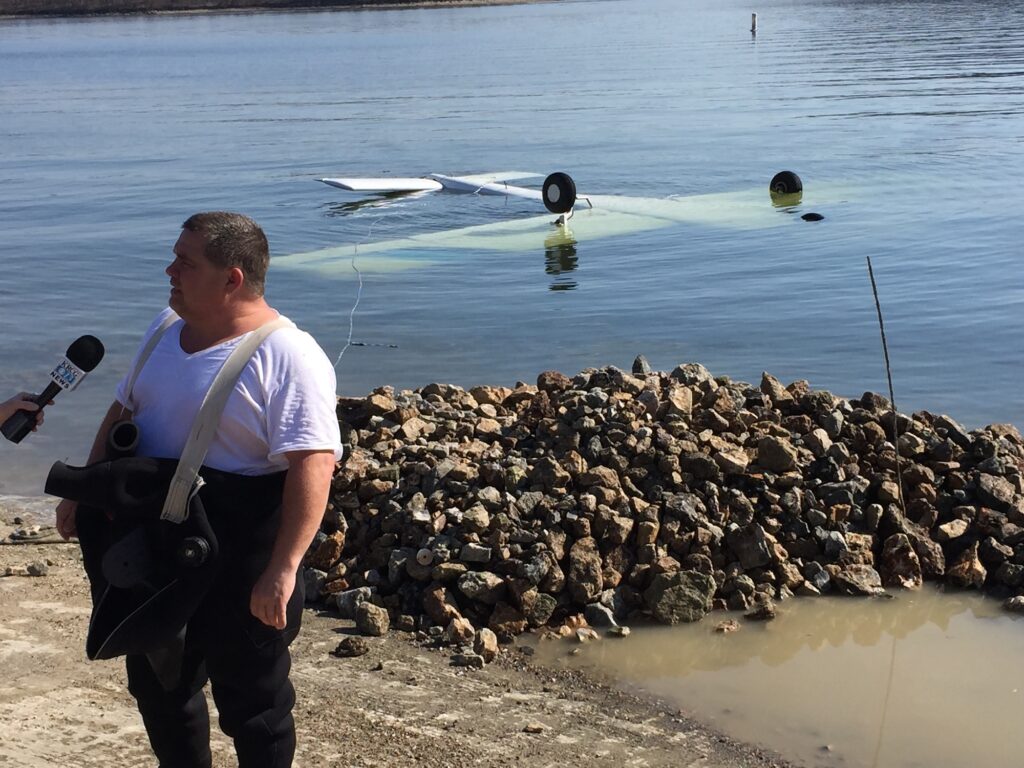
Photo by Nathan Bechtold
The Walrus got called to the job. After using airbags to raise the plane to the surface, crews from Atlantis Dive and Dock Salvage, Lake Tow, and the Missouri State Highway Patrol towed it to the boat ramp at PB2. There they faced the challenge of how to flip the plane right-side-up without seriously damaging it.
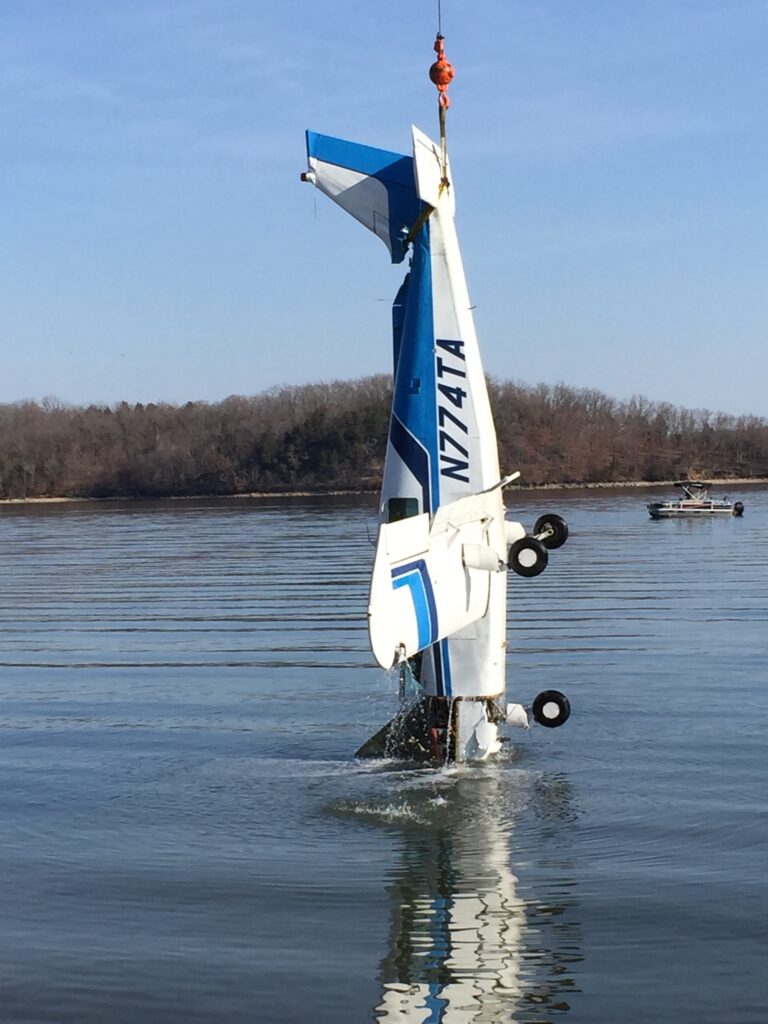
Ultimately, a crane was brought in, but a first attempt to lift the plane by latching onto one of its tie-down hooks failed: the hook snapped off the water-laden aircraft. The plane was completely vertical — nose-down, dangling above the water — when the hook broke and it plunged dramatically back into the Lake.
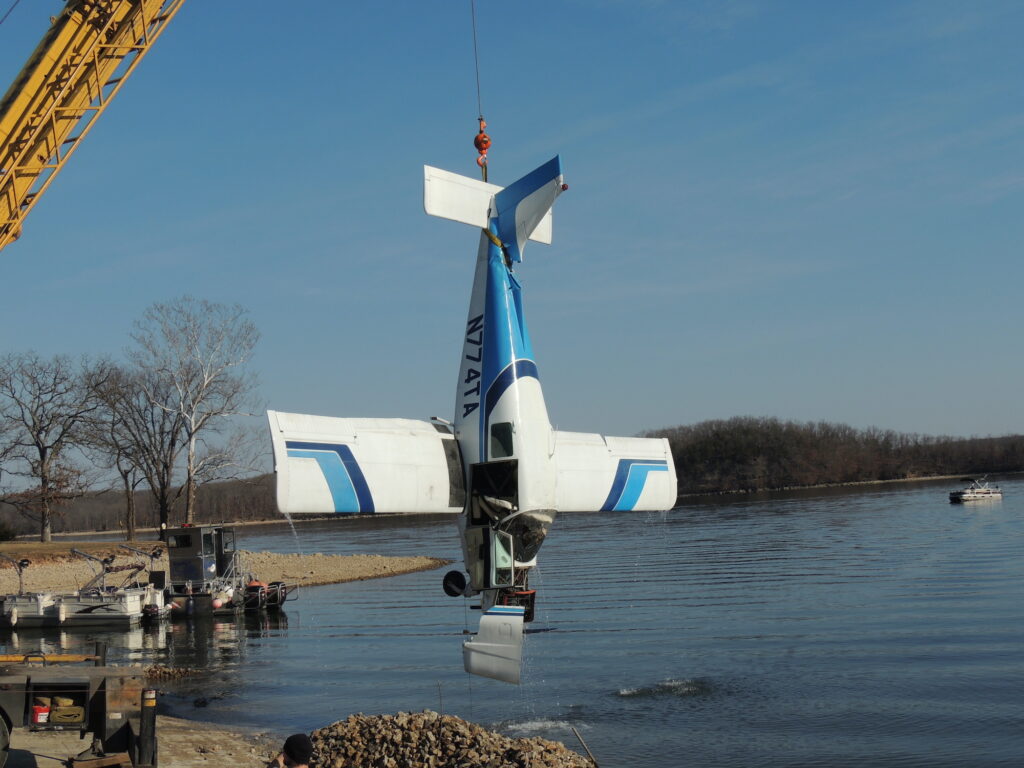
Photo by Nathan Bechtold
In the end, a large strap wrapped around the tail section allowed the crane to lift the plane, move it to the ramp, and set it down. The plane was loaded onto a tow truck and taken to a hangar to be inspected by the Federal Aviation Administration.
The ‘Dozer
Yes, The Walrus floated a bulldozer.
The ‘dozer sat beneath 60 feet of water, perched on a ledge: a mistake could result in another 35-foot drop to the Lake floor.
McNitt typically uses airbags to lift large sunken items. A few airbags will lift most boats right back up to the surface: he dives down, strategically places the (deflated) airbags, and then inflates them from the surface. But it was trickier with the ‘dozer. Placing the bags on it and starting to fill them with air could have tipped the heavy machine off the ledge, sending it much deeper into the Lake. It was ticklish work.
After raising the ‘dozer to the surface, the hardest part of the job still lay ahead. The number of airbags required to lift that large of an object created enormous drag for the tow boat that had to pull it to shore. McNitt towed the floating bulldozer for two miles, idling along at a top speed of one mile per hour.
Once ashore, a massive crane lifted the ‘dozer out of the Lake.
The Houseboat
And in early 2017, Atlantis raised a 50-foot houseboat off the Lake floor. That one was a fixer-upper that never got fixed up; the years went by and one day, the owners looked outside and noticed something was missing! Crews from Atlantis Dive & Dock Salvage and Lake Tow utilized airbags to float the gargantuan boat. They towed it to a nearby ramp, where two wreckers pulled it to shore. The boat was unsalvageable other than for some scrap metal. Crews cut it up, scrapped the metal, and put the rest into dumpsters.
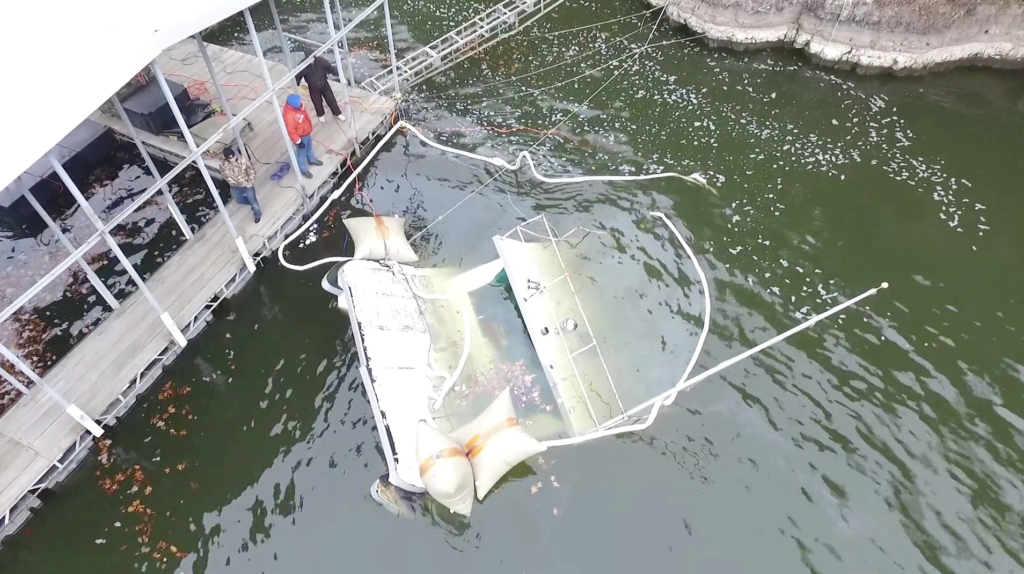
Photo courtesy of Lake Tow & Atlantis Dive & Dock Salvage
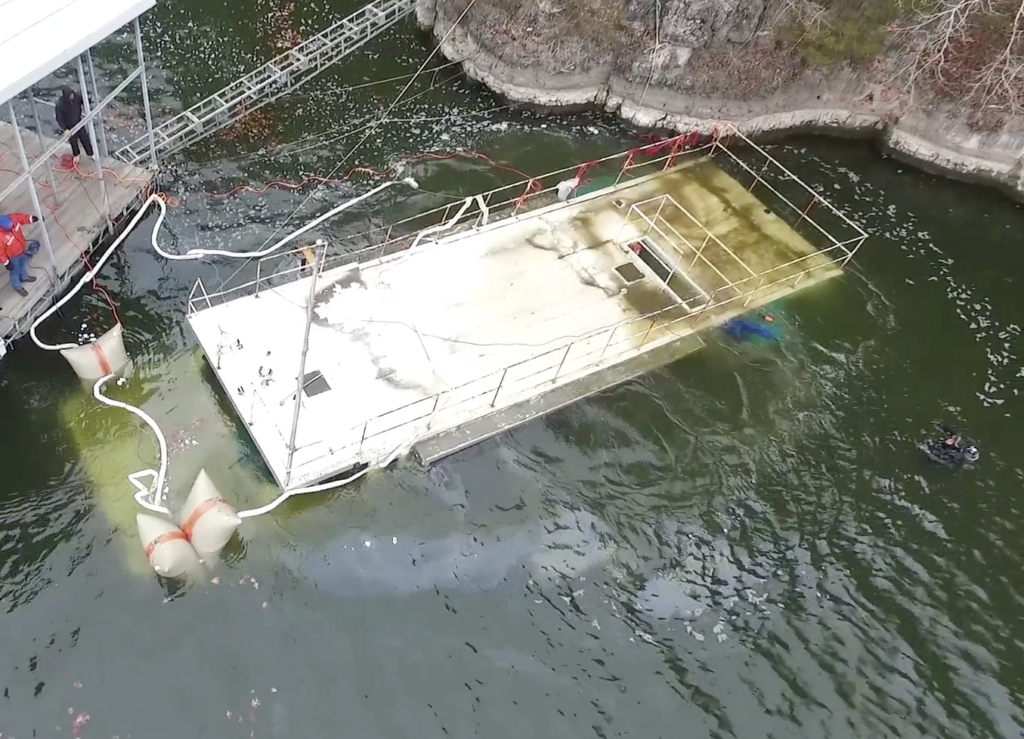
Photo courtesy of Lake Tow & Atlantis Dive & Dock Salvage
The Flying Walrus
And then there was the routine boat-raising that got wild in a hurry. Floating a sunken boat is a fairly common task for Atlantis, and to hear McNitt tell it, the day started out like many others. He and his team were called in to raise a 27-foot Fountain standing on its nose in 70 feet of water. The team assessed the situation, attached airbags, and filled them, but (unbeknownst to the Atlantis crew) the boat’s bow was firmly stuck in the mud.
In these kinds of operations, the job of the diver is to make sure the airbags are properly positioned and to reposition them to improve airflow, as needed. Perplexed as to why the boat wasn’t coming up, McNitt—in full diving gear—started working his way down one of the ropes attached to the sunken vessel, searching in murky water for a kink in a bag or air hose that could be blocking the air.
Just as he arrived at the nose of the vessel, it broke free. The boat rocketed to the surface, with McNitt hanging on. Amid the chaos, he had the presence of mind to exhale on the way up in order to prevent what’s commonly known as “the bends.”
He was still holding on as the 27-foot Fountain violently erupted above the surface. But McNitt didn’t stop at the surface: the momentum tossed him through the air in a 30-foot arc. Incredibly, he was unhurt, and thrown clear of the boat—which was bobbing on the surface just where they wanted it to be.
As McNitt finished up the job, he learned his expectant wife had gone into labor. He grabbed chocolate milk and donuts for dinner and tore out for the hospital, but his haste came to the attention of a local police officer. Stressed from his recent aquatic and aerial acrobatics, and anxious to be by his wife’s side, Tim was slow to pull over. When he finally did, he asked the officer what he was being stopped for, and the officer countered by asking if McNitt had seen the emergency vehicle.
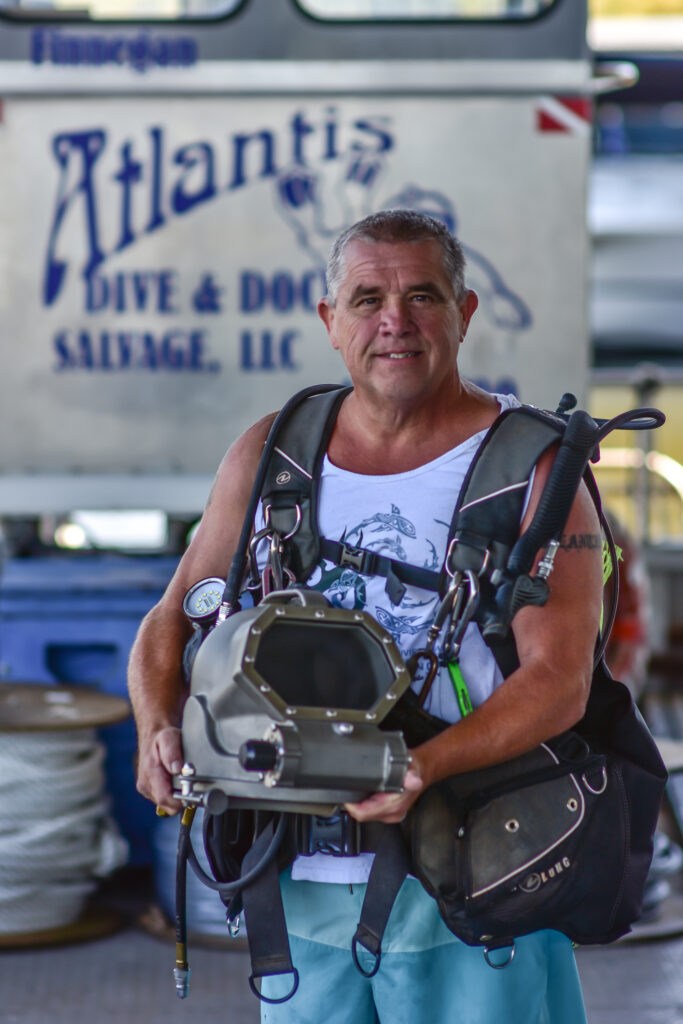
Photo by Lake Shots Photography
“What emergency vehicle?” he asked. “Mine,” the officer answered.
Tim apologetically said he’d been distracted while trying to rush to the hospital. Yes, he offered the cop a donut, and it was at that point in the day that Tim’s luck finally turned. Soon he was off, with all his donuts, ready to end a wild day at work by greeting his newborn son.
